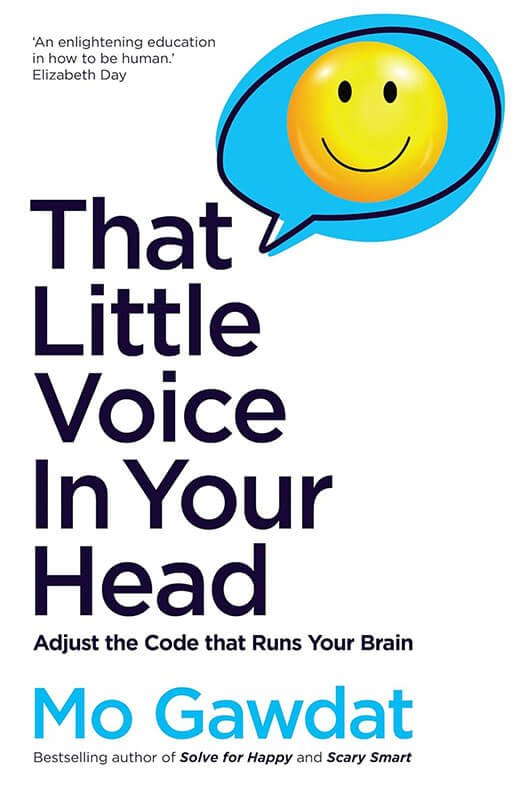In “That Little Voice in Your Head: Adjust the Code that Runs Your Brain,” former Google X executive Mo Gawdat offers a revolutionary approach to understanding and managing our internal dialogue.
As a follow-up to his acclaimed book “Solve for Happy,” Gawdat combines his engineering mindset with deep personal insights to tackle one of humanity’s greatest challenges: the constant chatter of our minds.
Published in late 2022, this groundbreaking book arrives at a crucial time when mental well-being and inner peace have become more important than ever.
Core Concepts
The book’s foundation rests on the premise that our inner voice – that constant narrator in our heads – can be our greatest ally or our worst enemy. Gawdat presents a systematic approach to transforming this internal dialogue through several key principles:
- Understanding the nature of thought and consciousness
- Recognizing the difference between useful and harmful internal dialogue
- Developing practical techniques to reprogram negative thought patterns
- Creating sustainable habits for maintaining mental clarity
- Building a healthier relationship with your inner voice
Chapter-by-Chapter Review
Part 1: The Neural Causes of Suffering
Mo Gawdat opens the book by helping us understand why our brains so often work against us. Designed for survival, our neural wiring is constantly on the lookout for threats, which can leave us anxious, restless, or unhappy even when nothing’s truly wrong.
Through clear explanations and relatable stories, Gawdat shows how these mental loops aren’t a personal failing but a natural byproduct of how the brain evolved. By identifying these patterns, readers can start seeing suffering as something we can gently manage, rather than an unavoidable life sentence.
Part 2: The Side Effects of Thought
In this section, Gawdat explores how the non-stop chatter in our heads directly shapes our mood and actions. Overthinking, self-doubt, and judgment aren’t just annoying—they can distort reality and prevent us from enjoying life.
Instead of criticizing us for these habits, he invites us to notice them with curiosity. Using humor and everyday examples, Gawdat explains that the goal isn’t to stop thinking altogether but to understand how thoughts influence us. That awareness alone opens the door to more freedom, clarity, and self-compassion.
Part 3: The Neural Path to a Happier Life
The final part of the book shifts from awareness to transformation. Here, Gawdat introduces practical tools for retraining the brain toward peace and happiness. He blends science with mindfulness, offering exercises that help us reframe negative thoughts, build healthier mental habits, and strengthen our inner resilience.
Gawdat’s advice feels both realistic and hopeful: you don’t need to eliminate thoughts or achieve perfection, just learn to relate to them differently. By following these steps, readers can create a calmer inner dialogue and a more joyful daily life.
Key Strengths
- Combines scientific rigor with accessible language and practical applications
- Offers concrete, actionable steps rather than just theoretical concepts
- Includes engaging personal stories and examples that make the content relatable
- Provides a systematic approach to mental well-being
- Balances Eastern wisdom with Western scientific understanding
Potential Drawbacks
- Some readers might find the engineering analogies too technical
- The practices require significant commitment and consistent effort
- May feel overwhelming for those new to mindfulness and self-development
Who This Book Is For
This book is particularly valuable for:
- Professionals dealing with high-stress environments and constant mental chatter
- Individuals seeking practical tools for managing anxiety and negative thoughts
- Self-development enthusiasts looking for a scientific approach to mindfulness
- Anyone struggling with their inner critic or seeking greater mental peace
Final Review
“That Little Voice in Your Head” stands out as a masterful blend of practical wisdom and scientific understanding. Gawdat has created a thoughtful and practical guide to understanding how our brains create both suffering and joy. Drawing on neuroscience, psychology, and personal experience, he explains why our inner voice often sabotages us and how we can shift it toward positivity.
The book stands out for its mix of science and compassion, offering clear exercises to “reprogram” unhelpful thought patterns. Gawdat’s message is empowering: happiness isn’t luck—it’s a skill we can all learn.
Rating: 4.6/5
This book is an invaluable resource for anyone seeking to master their inner dialogue and create lasting positive change in their life.

Alternative Books
Consider these highly-rated alternatives for different perspectives on mental well-being and personal development:

“The Power of Now” by Eckhart Tolle
A spiritual approach to present-moment awareness and transcending negative thought patterns
Rating: 4.6/5

“Mindfulness in Plain English” by Bhante Henepola Gunaratana
A practical guide to meditation and mindfulness practices
Rating: 4.7/5

“10% Happier” by Dan Harris
A skeptic’s journey into meditation and managing the mind, written with humor and practicality
Rating: 4.4/5





